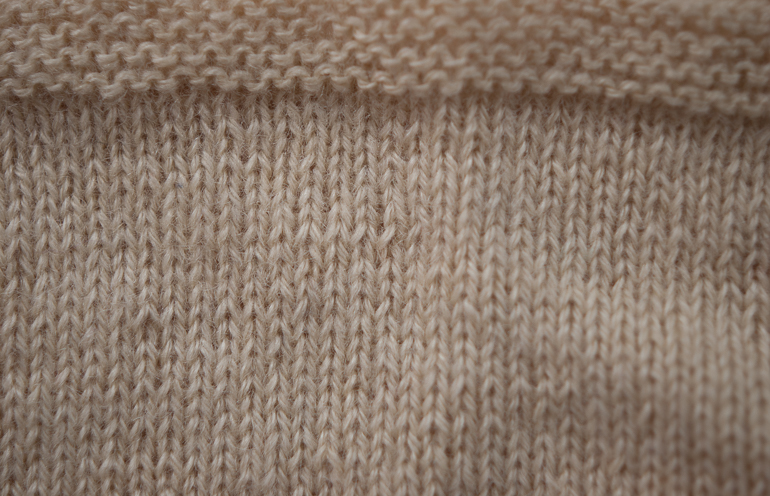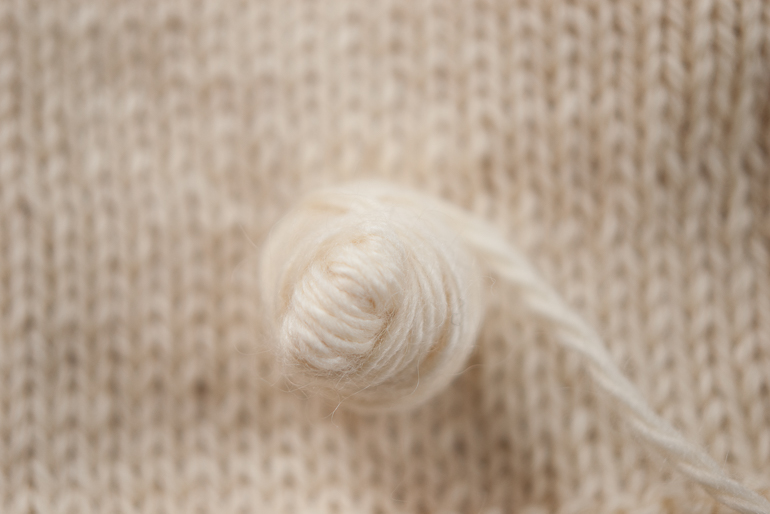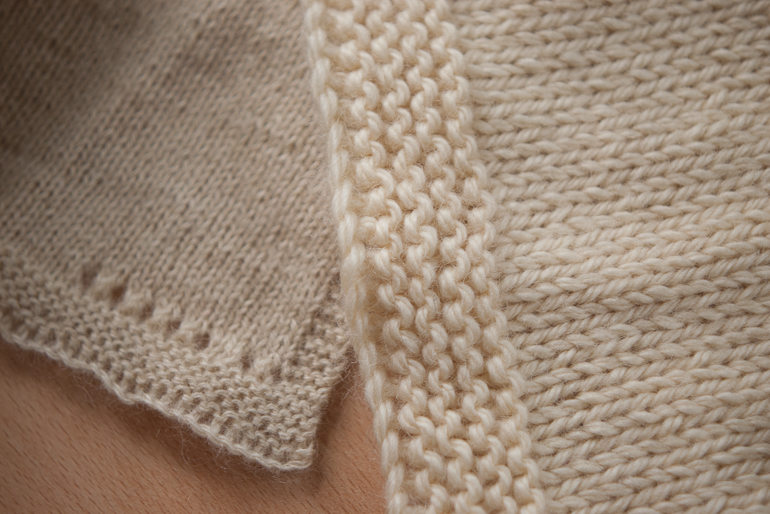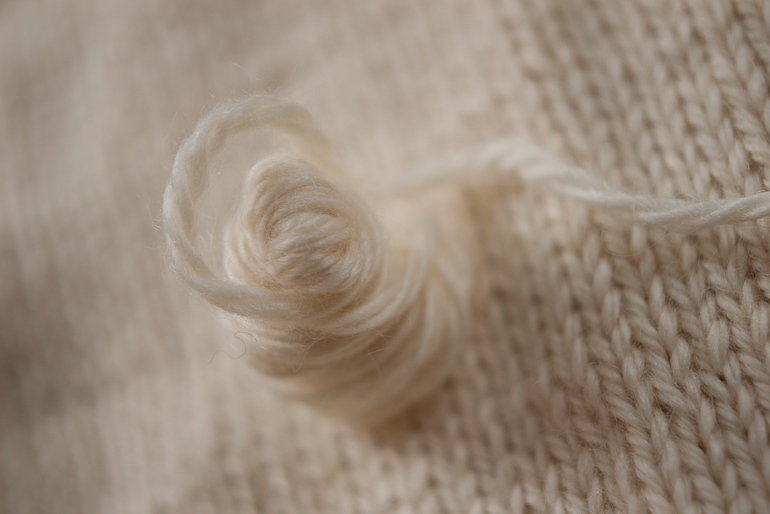Today we wanted to try something out here on the WOVEMBER blog and share a conversation between a Producer of Yarn (Jane Dryden of Home Farm Wensleydales) and a Consumer of Yarn (me, Felix, TEAM WOVEMBER MEMBER and WOOLFAN). Jane sent me some of her different hand knitting yarns and I swatched with them, noting characteristics and qualities and my observations as I went; I then sent these to Jane, who offered her own comments in exchange. We thought you might enjoy our conversation and we hope – naturally – that it will lead to more discussions between Producers and Consumers of WOOL.

The Pure Wensleydale yarn – natural 3-ply
Felix: I was immediately drawn to your pure Wensleydale yarn and have worked a swatch on 2.5mm needles using your white 3-ply. I’ve learnt a lot through knitting this swatch; it’s given me new perspectives on what Wensleydale can be used for and it’s made me think about the difference between how yarn feels in the ball and how it works up into knitted fabric.

I’ve worked with Wensleydale before and generally found it to be quite a drapey sort of wool and therefore perfect for lace and openwork, but this particular 3-ply yarn works up beautifully in stocking stitch when knitted at a tight gauge and I can’t believe how light and lofty the fabric is, not to mention warm. It does have a delicate prickle but I enjoy the feeling of life and character in that sensation. I keep looking at my little swatch and wondering about making a shawl – something that involves acres of plain stocking stitch and some lace details…

An initial squeeze doesn’t do justice to this yarn; it is a glorious golden colour and you can really see the lustre in the Wensleydale fibres. But the initial squoosh – what my friend Louise calls “the hand squish grab” – gives an impression of crispiness that all but disappears after you’ve knit with it. I feel this yarn is transformed through knitting, and my finished swatch has very good stitch definition and a glorious fuzzy halo on its surface. I can’t stop petting it – genuinely – it’s so airy for Wensleydale, and the plies – which look quite defined in the ball – smooth out into little plump stitches on the needles. I remember a hand spinner telling me that 3-ply yarns are more “round” than 2-ply yarns and this round quality really shows in your lovely pure Wensleydale 3-ply.
One thing I did find was that when I was knitting this 3-ply my swatch kept kinking up on me and rolling up at the cast-on edge in spite of my working a garter stitch border to stabilise the knitting. I wondered if this is something to do with the twist of the plies themselves or perhaps even the curliness and bounce in the fibres of the Wensleydale fleece?
Jane: I’m not sure how much is the spinning process or the natural fibres, but I do know when I look at the fleece hanging off the sheep the Wensleydale fleece hangs beautifully with the natural weight of the fleece curling down with the white lustre moving to golden at the tips.

Felix: I love the words on the ballband: “Natural Rare Breed Wensleydale From our farm in The Cotswolds” is music to my ears, along with “100% British Wool washed and spun in Yorkshire”. It’s also superb to see a sheep from your own flock peeping out there from the label, making the connection between your farm and the yarn! However – and I hope you won’t mind my pointing this out – I was wondering how the knitter who encounters this ball of yarn might learn more about its provenance? Given how beautiful your sheep are and that you have a lovely website where people can learn about them, I did wonder whether your URL couldn’t be there too. And it would also be really useful to know roughly how many metres/yards there are in a ball of this stuff so that if I did ever get around to making a shawl out of it I could plan how many balls to buy!
Jane: You are so right, I should have included the url on the ballband but I very much started off in the order of building a beautiful flock of sheep, then finding people who could turn the fleece into the highest quality yarn and then lastly the marketing and the internet which I am afraid I am not very good at. My later ball bands do include www.homefarmwensleydales,com. The meters/yards is an interesting story in itself. I can recall Laxtons calling me and asking me where the meters/yards were on the ball bands. My response was “why do you need to know that” and the spinners response exactly matches your question – how many balls do you need to buy. I am learning quickly and this will be on the ballband from my next spin – hopefully back with me by end January in double knitting and 4 ply.
Felix: I have some other balls of Pure Wensleydale from you and you put in an explanation of why each is slightly different; I wondered if you could tell me a bit about working with different spinning mills, and how your yarns have developed in relation to the mills with which you work?
Jane: My aran was the very first fleece that I had spun and at that time my shearing weight was 30kg fleece. With smaller amounts you are very limited to who will spin for you and it can work out quite expensive. This first shear was kindly spun for me at The Natural Fibre Company. My second year I had only 23 fleeces to spin and decided to try Halifax Spinning Mill, where Paul was absolutely fantastic. He spun the black and white fleece separately into 2 and 3 ply but he was only able to spin woollen style and I believe Wensleydale really should be spun worsted.
I then visited a number of different spinning mills and realised I needed to increase the size of my flock in order to have a wider choice – which meant lambing and sheep health for the next few years became my priority. I went to college for a year and studied ‘Sheep’. I have now found Laxtons in Yorkshire who offer an excellent service and are full of great ideas.
Felix: In your journey to find the right mill, you have created several batches of yarn. Will the 3-ply Wensleydale ever be repeated or is it like a vintage wine from a particular year that we will probably not see again?
Jane: I am getting a trial spin done in naturally coloured pure Wensleydale which should be available in January but it won’t be the same as all mills seems to spin this fibre differently and of course this will be worsted spun.

Felix: I just have to ask: who is the sheep on the ballband for the 3-ply?!
Jane: Well, all of my flock are my favourites, but there are always one or two who either through illness or feeding(!!) become your best friend!! The white Wensleydale on the ballband from my first wool is Eileen and she was one of the first sheep that I ever bought. Their fringes can cause problems sometimes and Eileen managed to pick up a thistle in her fringe which infected her eye. She was in our garden for several months being carefully nursed and thankfully can see properly again after this trauma. Eileen is so helpful when I need to gather the flock in – I shout ‘come on Eileen’ and she comes running!
100g Big Wool – natural
Felix: This yarn is a revelation and I cannot stop petting it. I’m knitting a swatch on 6mm needles and am thrilled with how it’s turning out. I am not usually a lover of soft wools because I feel they tend to lack personality. Also in my experience the really soft wools seem to pill and look ratty really quickly because they don’t usually possess the qualities that make a yarn hardwearing – high twist, a little bit of grit and prickle… But your buttery soft Big Wool yarn is an exception! It’s got presence and woolliness yet feels silky and smooth to the touch and it looks to me as though it will wear well in my road testing.

There’s less of a difference here between the airy plump yarn ball and fat bouncy stitches worked in this yarn; the hand-squish-grab really gives an instant impression of the soft and silky nature of the yarn. As with the 3-ply there is a pleasing golden hue to the natural white, though I notice that the Big Wool is lighter; is that something to do with the addition of the Bluefaced Leicester wool in the blend?
Jane: You are exactly right. The Bluefaced Leicester is an incredibly fine fibre and given that the Bluefaced Leicester originated from the same ram as the Wensleydale, the wool seems to blend perfectly together and retains the lustre of the wensleydale but is lighter with the BFL.

Felix: The 3 plies in the Big Wool have the same rounding effect as in the much slimmer Wensleydale, and stitches come out beautifully defined and plump. Your label for this yarn is in a whole new league from that on the 3-ply yarn which makes me think that these two yarns come from different points along a learning journey of producing and marketing yarn. I love that you have included the URL for your website and a photo of the beasties from which the yarn came. Do I espy a Wensleydale and a Bluefaced Leicester sheep grazing side by side?

Jane: Yes, I could not believe my luck when I saw the two of them grazing together in the field and for once, had my camera with me!

Felix: You have created a very vibrant palette in the Big Wool range and I wondered if you could tell me about the inspirations behind the different colours?
Jane: We are incredibly lucky to be able to farm on ancient ridge and furrow, in the Cotswold Conservation Area and there are so many inspirational colours on our farm to give to the wool. Boysenberry – the sloe berries that we use in our sloe gin in October, Amber – the oxlip wild flowers which come in spring into our woodlands, Tangerine – rosehips in our hedgerows in autumn, Leicester Blue – the blue mist from the wild garlic which grows in abundance on Edgehill.
Felix: Lastly it feels to me as though these are two very different yarns for very different markets. The pure Wensleydale wins on sheep factor for me; it is the sort of yarn for which I would really enjoy finding a very special lace pattern and planning out a project to show off my knitterly credentials. Perhaps a shawl with acres of stocking stitch and a fancy border… I love how it works up at a tight gauge and it gives me a sense of having come from a very particular kind of animal. I love Wensleydale sheep with their long locks and large frames, and the lustre, loft and hairy halo are all full of their personality somehow. But I am a sheep nerd with a professed obsession in particular sheep breeds and yarns with character… and things like the kink in the yarn and the interesting darker shade of white really appeal to me. Is this sort of yarn harder to market to a mass audience of knitters than, say, the Big Wool? Because the Big Wool strikes me as being a real crowd-pleaser. It’s like the track on a record that gets the whole room dancing because it still has significant sheep factor, but you don’t need much commitment to work with it. It’s huge, knits up really fast, feels satisfying and warm, and won’t alienate anyone with prickle factor! The colours feel like a totally different sort of thing from the landscape-like shades of the natural pure Wensleydale yarns you have produced; they are somehow much more urban and contemporary. I wondered if you encounter different types of knitters when you are selling yarn from your farm, and what part customers have played (if any!) in influencing the direction in which you have taken your yarns?

Jane: The pure Wensleydale is loved by enthusiasts and knitters who understand and value rare breeds whereas the ‘big wool’ is targeted for a wider audience, either first time knitters or lapsed knitters who want to try again and a younger market who are up and coming knitters. I find that the first thing they do is pick up the wool, put it against their cheek and love the softness. I don’t want to process the wool into supersoft or wash easy – I want to keep my wool as pure and simple and, of course, every fleece from my own farm.

It’s been really interesting to think about these different yarns in terms of what they might best be used for, and to knit with two such different products from the same farm… It’s also been wonderful to learn more about Jane’s work through her Wovember postings and to get to know the yarn from the farm that we heard about during Growing Wool. I hope it was useful for Jane to hear my thoughts about her yarn – for me it is a privilege to be able to correspond to directly with a wool-grower. If you are at the Harrogate Knitting & Stitching Show this weekend please say hi to Jane from all of us here at Team Wovember! Fx